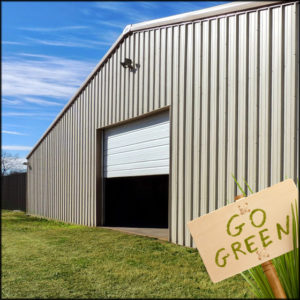Steel Recycling Leads the Pack of Green Building Materials
Eco-friendly green buildings usually include recycled building materials— especially recycled steel.
Why?
Because no other material on the planet comes close to matching the recycling record of steel.
Why Steel Recycling Rules the Market Today
 Steel is 100% recyclable.
Steel is 100% recyclable.- Steel retains all its strength when recycled. Recycle steel hundreds of times— and it is still just as strong as it was the first time. No other material can make that claim!
- Steel is the most recycled material in the world.
Every steel product you buy today contains recycled steel.
- Iron and scrap recycling produces new major appliances, motor vehicles, food containers, machinery, derricks, pipes, bridges, ships, trains and rails, various consumer products— steel-framed buildings— and more each year.
- Recycling is not a new concept in the steel industry. North American steel companies have been recycling steel for over 150 years.
- Steel mills and foundries actually depend on iron and steel scrap for production. Scrap steel is an essential ingredient in making new steel.
- Giant industrial magnets separate steel easily from the solid waste stream, making it economical to recycle steel.
Recycled Steel Production Facts
- According to the American Iron and Steel Institute, U.S. steel consumption is 70 million tons per year.
- Steel mills shipped 81 million net tons of new steel products in 2020.
- All across North America, more steel is recycled every year than aluminum, glass, paper, and plastic combined.
Steel Recycling Saves Energy
- It takes far less energy to melt and recycle steel than to create virgin steel from iron ore.
- Every ton of steel recycled saves 642-kilowatt hours of energy— 10.9 million Btu’s of energy.
- Recycling steel saves enough energy every year to power 18 million households for 12 months.
- Steel requires 34% less energy to produce today than it did 50 years ago.
How Recycling Steel Saves Resources
 Every ton of recycled steel conserves 2,500 pounds of iron ore, 1,400 pounds of coal, and 120 pounds of limestone.
Every ton of recycled steel conserves 2,500 pounds of iron ore, 1,400 pounds of coal, and 120 pounds of limestone.- The more steel we recycle, the less products end up in overcrowded landfills. According to the EPA, 600 million tons of construction debris are dumped into U.S. landfills annually.
- Every ton of steel that is recycled— rather than discarded— saves almost 250 cubic feet of landfill space.
- Automobile recycling in North America recycles enough steel each year to save about 85 million barrels of oil.
- Steel mills today reuse 95% of the water used in processing.
- Innovations in steel production— and conservation efforts by the North American steel industry— have slashed air and water emissions by 90%.
- The steel industry has dramatically increased effectiveness in steel production. Today crating a ton of steel takes only 5.3 man-hours.
- Framing for a 20,000 sq. ft. commercial steel building can be produced from the recycled steel from 50-60 junked cars. (On the other hand, framing the same building with wood sacrifices 10 acres or more of forest.)
- Choosing steel framing over wood framing also means leaving more trees growing and replenishing our atmosphere with life-sustaining oxygen.
- With RHINO steel buildings, 100% of the steel framing and steel cladding is recyclable at the end of the structure’s lifecycle.
Today’s “New” Steel
- Today’s steel is 30% stronger than steel produced a decade ago.
- The Golden Gate Bridge construction could be built today with half as much steel as originally used.
- All steel contains 28% or more recycled material.
- Structural steel on average contains 77% recycled content.
More Steel Recycling Trivia
 Steel cans recycle at an astonishing rate of 630 cans per second.
Steel cans recycle at an astonishing rate of 630 cans per second.- The average American discards about 61 pounds of metal cans every month.
- Recycled steel comprises 75% of all major appliances.
- Steel roofing lasts over 50 years; asphalt roofing lasts only 17 years, on average. Surprisingly, asphalt roofs also weigh twice as much as steel roofing.
- Choosing reflective cool-coated steel roofing in warmer climates saves an additional 15% on utilities.
- Steel doors are fire-resistant. Futhermore, steel doors protect ten times better than wood doors against intruders.
- Steel framing does not crack, split, twist, rot, or creep like wood framing. It also promises better protection from high winds, heavy snows, fire, mold, vermin, termites, and earthquakes than ordinary wood framing.
Conclusion
When you build with salvaged steel and recycled steel building materials, you get the best possible structures for you and the most eco-friendly buildings for our planet.
Green Buildings Framed with RHINO Steel
 No other building material is greener than red iron steel.
No other building material is greener than red iron steel.
Not only do RHINO steel buildings boast a high recycled content, but our steel buildings also last decades longer than stick-built structures. The longer any product’s lifecycle, the less impact it has on the environment.
At the end of the structure’s usefulness, the steel framing and exterior panels recycle again, to start another useful life as a washing machine, automobile, bridge, train, submarine— or even another steel building.
Make the environmentally sound choice: build with RHINO. Call 940.383.9566 today for more information about our green buildings.
(Updated 4-21-2021. Originally published 11-14-2014.)
